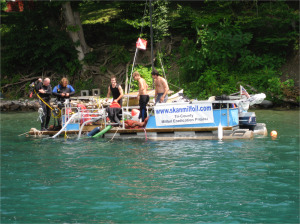ALERT: Harmful Algal Blooms (HABs) have been observed in the south eastern end of the lake. LEARN MORE
[vc_row][vc_column width=”1/1″][vc_column_text]
 The Skaneateles Lake Association and its predecessor organizations over a few years of effort and trial formulated a system of a combination of hand-pulling and benthic matting as the best approach to controlling Milfoil.
The Skaneateles Lake Association and its predecessor organizations over a few years of effort and trial formulated a system of a combination of hand-pulling and benthic matting as the best approach to controlling Milfoil.
A two-phase program for achieving the goal of controlling the Milfoil was devised. Phase one was a major effort to reduce the biomass of milfoil in the lake to stop the spreading. Milfoil in Skaneateles Lake reproduces almost entirely by fragmentation, i.e., pieces of the plant when sinking to the bottom in a suitable location can put out roots and develop into a new plant. If you are able to reduce the number of fragments being produced by reducing the biomass then you can reduce and even stop the spread of milfoil. So that was our first effort, reduce the size of the reproducing population. Phase two was the maintenance phase. Realizing that with an area some 35 miles long and about 100 yards wide that it would be impossible to remove every single plant in the lake. We knew that after the eradication phase we would have to initiate a maintenance phase where we regularly check for milfoil and removed any large patches. We are currently in the maintenance phase (2014). We now conduct a survey at the end of each summer, identifying the patches and their location and then scheduling them for removal the following summer.
Hand-pulling – At first most of the removal was done by hand-pulling. We started with 3 dive boats and some 15 divers in 2007, which quickly expanded to 5 boats and some 30 divers. This was effective but very time and manpower intensive, so we experimented with another method.
Benthic Matting – John Menapace of Aquatic Invasives devised a very effective system of milfoil control using benthic mats. We purchased 300 ft X 12 ft rolls of geotextile material commonly used in road building. Sixty foot long segments were prepared, weights were attached to the mats and they were rolled up on 14’ – 2” X 4”s. The mats could then be taken to the site and deployed by the divers. The mats were lowered into the water and the divers would position them over the milfoil and roll them out. They were left on the bottom for a minimum of 8 weeks and then retrieved. Retrieval involved divers rolling the mats up and workers on the boat lifting them out of the water where they were returned to Aquatic Invasives for storage. A total of 4.9 acres of matting was thus prepared and deployed each year. Matting has been the primary method of controlling milfoil since 2009. Hand-pulling has been used in sites that are difficult to mat during the interval between deployment of the mats and their later removal.
Gaining control and maintenance phases – It took about 5 years before we felt that we had reduced the population sufficiently to enter the maintenance phase. We have been in the maintenance phase since 2012.[/vc_column_text][/vc_column][/vc_row]